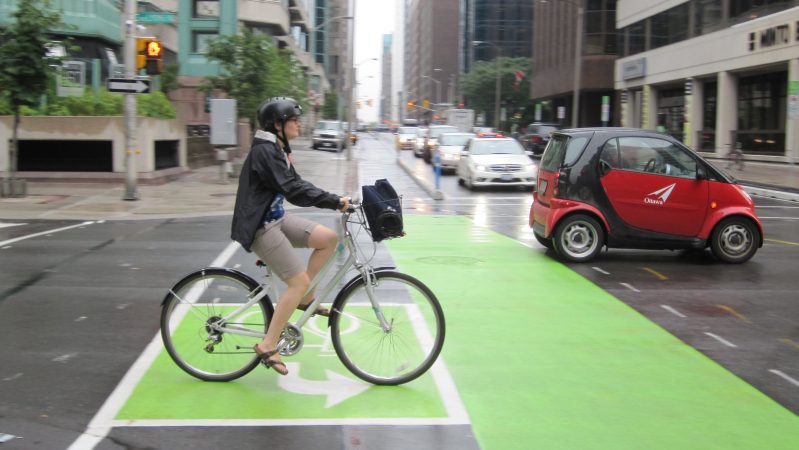Today, December 14, the City of Ottawa’s budget for 2017 was discussed and passed at council (24-0). City budgets may not get most people excited, but this one is special. What makes it unique is that the city has received money from the federal public transit infrastructure fund (PTIF).
We are thrilled to note that city staff have proposed using some of these funds to leverage the city’s walking and cyling projects. So, rather than the approximately $7M per year that has been spent on cycling-related projects in recent years (which is not too bad compared to many North American cities), for 2017 alone we are looking at a total investment of close to $60M. This is the kind of spending that will really help to make cycling an option for many more people. Here are some of the highlights of what’s planned:
- 2015-2018 Cycling Facilities Program ($4M): This is the funding that moves Ottawa towards completing the $70M Ottawa Cycling Plan by 2031
- 2015-2018 Community Connectivity ($4.14M): A strategic initiative for this term of council to fill in “missing links” around the city. Many of these projects are for walking as well as for biking. This Community Connectivity initiative appeared in this council’s first budget (passed in March of 2015), and is a great new way to complement the Ottawa Cycling Plan.
- The Fifth-Clegg Bridge ($21M): This is a big deal, worthy of a post all on its own
- Cycle tracks on the new Booth Street bridge at Pimisi station ($2M): A long story… this will help it have a happier ending.
- A new Rideau River crossing, south of Carleton University ($1.55M): This is funding for the design; construction may be funded in a future budget.
- Billings Bridge/Bank Street underpass at Riverside ($2.05M): This will help some people avoid a dangerous intersection.
- Manotick bridges ($1.2M): Funding to design safe places to cycle across Manotick’s two main river crossings. Construction may be funded in a future budget.
- Sidewalks and bike facilities on MTO overpasses ($2M): Pinecrest Road has been identified as a possibility: it’s a hostile overpass due for replacement, where improved walking and biking facilities will help people access the LRT.
- Bike parking at transit stations ($0.65M): Covered and even some fully-enclosed parking, where there’s demand for more bike parking
- Initiatives that encourage modal shift, and help to make cycling safer ($1.405 M): Cycling Safety Improvement Program, Transportation Demand Management, Safer Roads Ottawa, Transportation Management Implementation Plan (TMIP) for Richmond Road/Westboro. This includes new bus shelters, new sidewalks and pathways, bicycle parking facilities, individual travel planning efforts, programs to encourage walking and biking.
- Many new cycle tracks and lanes along arterial roads ($5.7M): Including in Kanata North at Carling/Herzberg/March, Hunt Club near Paul Benoit, Richmond near Croydon, McArthur Ave, and Heron Rd near Bank.
- Multi-use paths ($4.3M): Phase 3 of the Trillium path, finally connecting to Dow’s Lake. Also, Rideau River western path, improved alignment of the Trans-Orleans pathway, Cardinal Creek path, MUP from Michael to St. Laurent
- Multi-use path renewal ($4.3M): Maintenance isn’t glamorous, but it’s (sorely) needed. MUPs near Byron, Greenboro, and Centrepointe have been identified for having the bumps smoothed out.
- 2017 Road resurfacing and rural cycling links ($4.56M): Enhancements include paved shoulders and cycling signage. This will make cycling a lot safer on rural highways. Trim Road was identified as one candidate.
Of course, these are only the projects where cycling is a major focus. We aren’t able to quantify how much is spent on cycling as a component of other major transportation projects, such as the Baseline rapid transit corridor, which is planned to include about 20 km of MUPs and cycle tracks.
Exciting times
This is an exciting time for Ottawa. We are seeing the kinds of investments that are needed if cycling is to become an attractive transportation option for everyone. After decades of under-investment in active transportation, it feels like a new attitude to city-building and sustainability is taking hold. The involvement of higher levels of government in funding active transportation is something that we’ve never seen before, and is a reflection of that trend.
Huge boost
We want to recognize the efforts that city staff and city council have made in taking full advantage of the PTIF funding to support active transportation. It would have been easy to just focus on the “transit” side of that fund – new buses, park-and-rides, shelters, and so on. But to really maximize access to our transit system, and to help people make sustainable trips to transit, investing in walking and cycling is a smart choice.
Matching funds
Through the commitment of other levels of goverment for providing matching funds, and due to our city seizing the opportunity, the 2017 budget will be a huge boost for active mobility. It will still be a few years before we can get out and ride on everything that’s planned here, but the future is looking bright.
With all that’s going on, our Advocacy Working Group is going to be busier than ever, following projects across the city. We’d love to have your help, especially if you frequent areas that are further from the core. If you want to learn how you can get involved, drop a line to advocacy@bikeottawa.ca Our next advocacy meeting is planned for January 18 at Causeway Work Centre.

